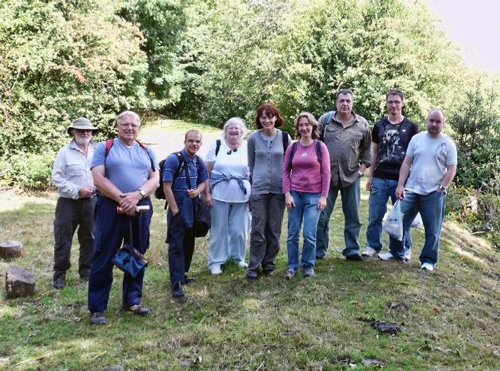
Our Summer trip last month turned out to be a great day out - thanks in no small part to Phil Cox who shook off the symptoms of a bad cold to show us round his sites at Bryn Alyn. Phil and his team of volunteers have been excavating this site for a number of years now and he was keen to show us his various projects. He is particular proud of the experimental archaeology which include beds of prehistoric cereal, an iron age round house and a small pottery kiln. This area also boasted some actual archaeology (although Phil is not exactly sure what it is). He has, however, identified activity from the Medieval period and a structure dating to the 17th century. There is also a stone lined cut-out in the hillside which, to me, looks like a corn drying kiln.
Bryn Alyn (or Caer Alyn) is best described as a promontory hill fort with the River Alyn surrounding it on three sides. A huge double bank and ditch system cuts it off on the fourth (north) side. The entrance seems to have been on the south side leading up from the river. Hill forts are usually associated with the Iron Age, however Phil's geophysics results indicate a curved cross ditch system lying outside the visible bank and ditch system. His excavations here have confirmed the size of this ditch and he has even identified a huge posthole that could represent the original entrance (with a second one a few metres away). Phil says the small pieces of pottery coming from the ditch suggest Bronze Age which, if proved right, would be remarkable as enclosures from this period are very rare.
After a picnic lunch on the ramparts of the hill fort, we moved on to Wroxeter, the famous Roman City with its huge bathhouse complex. Known as Viroconium, it was the fourth largest in Britain (although most of it is still unexcavated). It started life as a legionary fortress but at the turn of the 2nd century AD it was converted into a civilian settlement. The forum and bathhouse were added later in the early 120's AD. One theory is that these additions were on the behest of Emperor Hardian who visited Britain in 122 AD. Of particular interest to me is the similarity with Wigan's bathhouse - alright not quite as big but certainly contemporary (it even has the small side rooms like those at Wigan which here are said to be hot pools). Another similarity with Wigan is the colonnade running round the outside of the bathhouse (this is different from the forum which has its colonnade on the inside).
Although late in the day we decided to continue on to Shrewsbury where we were all impressed by its ancient buildings. Of particular interest was the Old Market Hall which was built in 1596 for the Drapers Guild - also the timber-framed Rowley's House. St Mary's Church was also interesting as its tower, to some extent, resembles Wigan's Parish Church tower - i.e. it is built from red sandstone (as we found out from our visit to Wigan's in July - see below).
After a great day, I'm afraid to say we all ended up at Loggerheads - the pub that is, which was just round the corner. After a refreshing drink in the quaint snug, we headed back to Wigan reflecting on the highlight of a successful day (for more pictures of our visit check out our Forum).
All Saints Parish Church
Our trip to the Church in July was also very enjoyable (pictures again on our Forum here). I would like to thank Peter Layland and his father for taking us round and allowing us access to the tower. Peter has also kindly offered his study of the Church for our Wigapedia pages (which you can see here).
Roman Manchester
Norman Redhead from the Greater Manchester Archaeological Unit is giving this talk on Tuesday 20th September at the Museum of Science and Industry. It starts at 7.00pm and the entrance is free. In Castlefield lie the remains of the birthplace of Manchester - the Roman fort and settlement of Mamucium. But how much do we know about these Roman roots? Norman will reveal all about this first age of Manchester. There is no need to book but if you want to find out more about the Castlefield area visit this website: http://www.ourcastlefield.co.uk
Next Meeting
Wednesday 7th September - this month we have Kevin Wright who is secretary of the Tameside Archaeological Society. He will be telling us about their society's recent excavations on the Hartshead Pike. The Pike is a hill on the outskirts of Tameside with rich history of occupation from Prehistoric to present day. I'm sure Kevin's talk will have something for everybody.
By the way, please remember that we are now meeting at the Pagefield Hotel at the crossroads of Gidlow Lane and Park Road (starting at 730pm as usual). - hope to see you there, - BA
|



